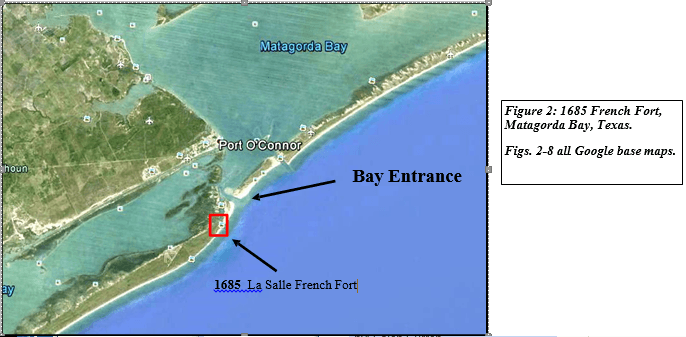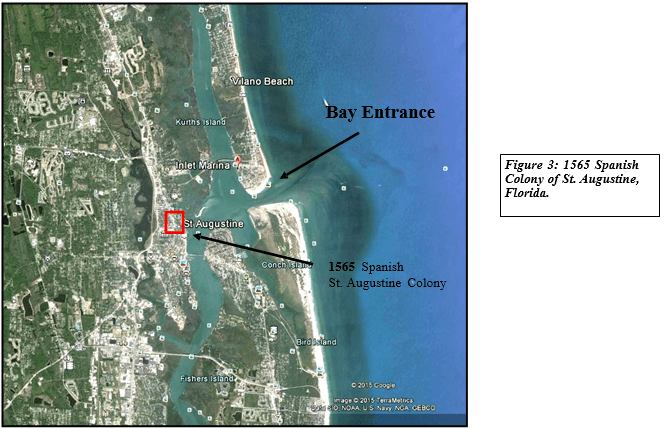A Cartographic Template for the 1559 Spanish Luna Colony?
by Caleb Curren
Contact Archeology Ink
A Cartographic Template for the 1559 Spanish Luna Colony ?
by: Caleb Curren
Contact Archeology Inc.
The premise of this article is relatively simple. Can we apply repetitious cartographic patterns of a substantial number of the earliest European settlements in the current United States to the possible location of the 1559 Spanish Colony on Pensacola Bay in northwest Florida?
Many of the early historic European settlement locations in the current eastern continental United States were remarkably consistent. Most of the earliest colonists preferred to establish their settlements at or near entrances to bays along the northern Gulf Coast and the Atlantic Seaboard.
The reasons for the consistent settlement pattern are, perhaps, a matter of conjecture, however, two hypotheses might be the most likely resolution to the conundrum. First, the colonists may have sought to settle themselves in a commanding geographic position to observe any territorial competitors entering “their” bay. Second, those early colonists may have sought to make it more convenient for any resupply ships from their homelands to spot their settlements near the bay entrances from the sea.
The following maps demonstrate this consistent “near the entrance” settlement pattern at most of the earliest coastal European colonies. There were rare exceptions to the pattern including the 1607 English Jamestown colony up the James River in Virginia. However, by far, the “near the entrance” coastal settlement pattern was distinctly consistent.
If the recent public media claims by the University of West Florida that site 8Es1 on Pensacola Bay is the indisputable 1559 Luna Colony then the template of cartographic consistency involving eight of the earliest European settlements in this country was totally ignored by the 1559 colonists. The early settlement fixations with bay entrances exhibited by the first mainland European colonization expeditions of 1565, 1566, 1585, 1685, 1698, 1699, and 1702 formed a repetitious pattern. Keeping in mind the need for fresh water, appropriate elevation, and a good fleet anchorage, the early European settlement template was a dictate … establish your colony as close as you could to the bay entrance. Conversely, the entrance to Pensacola Bay cannot be seen from site 8Es1.
Figure 1: Sample, Early European Colonies.
1. French, 1685, Matagorda Bay, Tx.
2. French, 1699, Biloxi Bay, Ms.
3. French, 1702, Mobile Bay, Al.
4. Spanish, 1698, Pensacola Bay, Fl.
5. Spanish, 1565, St. Augustine Inlet, Fl.
6. Spanish, 1566, Port Royal Sound, S.C.
French, 1562, Port Royal Sound, S.C.
7. English, 1585, Albemarle Sound, N.C.
Related Documents
Bense, Judith A.
2003 Presidio Santa Maria de Galve: A Struggle for Survival in Colonial Spanish Pensacola. University Press of Florida.
Gainesville.
Brasseaux, Carl
1979 A Comparative View of French Louisiana, 1699-1762: The Journals of Pierre Le Moyne d’Iberville and Jean-Jacques- Blaise d’Abbadie. The Center for Louisiana Studies.
Couch, Dora P., Daniel J. Carr, and Alex I. Mundigo
1982 Spanish City Planning In North America: a study of the Laws of the Indies as compiled in 1573.
The MIT Press, Cambridge, Massachusetts.
Curren, Caleb
1994 The Search for Santa Maria, a 1559 Spanish Colony on the Northern Florida Coast. Pensacola Archeology Lab.
Curren, Caleb, Keith J. Little, and Harry O. Holstein
1989 Aboriginal Societies Encountered by the Tristan de Luna Expedition. The Florida Anthropologist Vol. 42, No. 4.
Deagan, Kathleen
1980 America’s First Melting pot: Sixteenth Century St. Augustine. Archaeology 33(5): pgs. 22-30.
1980 Downtown Survey: The discovery of Sixteenth Century St. Augustine in an Urban Area. American Antiquity 46(3): pgs.
626-633.
DePratter, Chester and Marvin Smith
1982 Sixteenth Century European Trade in the Southeastern United: Evidence from the Juan Pardo expeditions 1566-1588).
(in) Spanish Colonial Frontier Research. (ed.) H. Dobyns. Albuquerque: Center for Anthropological Studies.
Galloway, Patricia K. (ed.)
1982 La Salle and His Legacy: Frenchmen and Indians in the Lower Mississippi Valley. University of Mississippi Press.
Jackson.
Hamilton, Peter J.
1910 Colonial Mobile. Houghton, Mifflin and Company. Boston and New York.
Little, Keith J. and Caleb Curren
1990 Conquest Archaeology of Alabama. Columbian Consequences: Archaeological and Historical Perspectives on the Spanish Borderlands East. (ed.) David Hurst Thomas. Smithsonian Institution Press.
Newspaper Articles:
2015 We found Luna’s colony. Pensacola News Journal: 12/18/15
2015 Luna Colony found, the search is over. Pensacola News Journal: 12/17/15
2015 Don Tristan de Luna settlement historic discovery. Pensacola News Journal: 12/20/15 2015 It’s a crowning achievement for UWF president. Pensacola News Journal: 12/20/15
Padilla, Fray Agustin Davila
1596 Historia de la Fundacion y discorso de la provincial de Santiago de Mexico de la ordende Predicadores.
Madrid. (Chapters 51-71, The Florida Expeditions).
Priestley, Herbert I.
1928 The Luna Papers. Publications of the Florida State historical Society No. 8: vols. I-II. Deland, Florida.
South, Stanley
1980 The Discovery of Santa Elena. Institute of Archeology and Anthropology Manuscript Series, No. 165. Columbia, South Carolina.
Quinn, David B.
1955 The Roanoke Voyages, 1584-1590. Hakluyt Society. London.
- Article
-
A Cartographic Template for the 1559 Spanish Luna Colony ?
by: Caleb Curren
Contact Archeology Inc.The premise of this article is relatively simple. Can we apply repetitious cartographic patterns of a substantial number of the earliest European settlements in the current United States to the possible location of the 1559 Spanish Colony on Pensacola Bay in northwest Florida?
Many of the early historic European settlement locations in the current eastern continental United States were remarkably consistent. Most of the earliest colonists preferred to establish their settlements at or near entrances to bays along the northern Gulf Coast and the Atlantic Seaboard.
The reasons for the consistent settlement pattern are, perhaps, a matter of conjecture, however, two hypotheses might be the most likely resolution to the conundrum. First, the colonists may have sought to settle themselves in a commanding geographic position to observe any territorial competitors entering “their” bay. Second, those early colonists may have sought to make it more convenient for any resupply ships from their homelands to spot their settlements near the bay entrances from the sea.The following maps demonstrate this consistent “near the entrance” settlement pattern at most of the earliest coastal European colonies. There were rare exceptions to the pattern including the 1607 English Jamestown colony up the James River in Virginia. However, by far, the “near the entrance” coastal settlement pattern was distinctly consistent.
If the recent public media claims by the University of West Florida that site 8Es1 on Pensacola Bay is the indisputable 1559 Luna Colony then the template of cartographic consistency involving eight of the earliest European settlements in this country was totally ignored by the 1559 colonists. The early settlement fixations with bay entrances exhibited by the first mainland European colonization expeditions of 1565, 1566, 1585, 1685, 1698, 1699, and 1702 formed a repetitious pattern. Keeping in mind the need for fresh water, appropriate elevation, and a good fleet anchorage, the early European settlement template was a dictate … establish your colony as close as you could to the bay entrance. Conversely, the entrance to Pensacola Bay cannot be seen from site 8Es1.
Figure 1: Sample, Early European Colonies.
1. French, 1685, Matagorda Bay, Tx.
2. French, 1699, Biloxi Bay, Ms.
3. French, 1702, Mobile Bay, Al.
4. Spanish, 1698, Pensacola Bay, Fl.
5. Spanish, 1565, St. Augustine Inlet, Fl.
6. Spanish, 1566, Port Royal Sound, S.C.
French, 1562, Port Royal Sound, S.C.
7. English, 1585, Albemarle Sound, N.C. - Related Documents
-
Related Documents
Bense, Judith A.
2003 Presidio Santa Maria de Galve: A Struggle for Survival in Colonial Spanish Pensacola. University Press of Florida.
Gainesville.Brasseaux, Carl
1979 A Comparative View of French Louisiana, 1699-1762: The Journals of Pierre Le Moyne d’Iberville and Jean-Jacques- Blaise d’Abbadie. The Center for Louisiana Studies.Couch, Dora P., Daniel J. Carr, and Alex I. Mundigo
1982 Spanish City Planning In North America: a study of the Laws of the Indies as compiled in 1573.
The MIT Press, Cambridge, Massachusetts.Curren, Caleb
1994 The Search for Santa Maria, a 1559 Spanish Colony on the Northern Florida Coast. Pensacola Archeology Lab.Curren, Caleb, Keith J. Little, and Harry O. Holstein
1989 Aboriginal Societies Encountered by the Tristan de Luna Expedition. The Florida Anthropologist Vol. 42, No. 4.Deagan, Kathleen
1980 America’s First Melting pot: Sixteenth Century St. Augustine. Archaeology 33(5): pgs. 22-30.1980 Downtown Survey: The discovery of Sixteenth Century St. Augustine in an Urban Area. American Antiquity 46(3): pgs.
626-633.DePratter, Chester and Marvin Smith
1982 Sixteenth Century European Trade in the Southeastern United: Evidence from the Juan Pardo expeditions 1566-1588).
(in) Spanish Colonial Frontier Research. (ed.) H. Dobyns. Albuquerque: Center for Anthropological Studies.Galloway, Patricia K. (ed.)
1982 La Salle and His Legacy: Frenchmen and Indians in the Lower Mississippi Valley. University of Mississippi Press.
Jackson.Hamilton, Peter J.
1910 Colonial Mobile. Houghton, Mifflin and Company. Boston and New York.Little, Keith J. and Caleb Curren
1990 Conquest Archaeology of Alabama. Columbian Consequences: Archaeological and Historical Perspectives on the Spanish Borderlands East. (ed.) David Hurst Thomas. Smithsonian Institution Press.Newspaper Articles:
2015 We found Luna’s colony. Pensacola News Journal: 12/18/15
2015 Luna Colony found, the search is over. Pensacola News Journal: 12/17/15
2015 Don Tristan de Luna settlement historic discovery. Pensacola News Journal: 12/20/15 2015 It’s a crowning achievement for UWF president. Pensacola News Journal: 12/20/15Padilla, Fray Agustin Davila
1596 Historia de la Fundacion y discorso de la provincial de Santiago de Mexico de la ordende Predicadores.
Madrid. (Chapters 51-71, The Florida Expeditions).Priestley, Herbert I.
1928 The Luna Papers. Publications of the Florida State historical Society No. 8: vols. I-II. Deland, Florida.South, Stanley
1980 The Discovery of Santa Elena. Institute of Archeology and Anthropology Manuscript Series, No. 165. Columbia, South Carolina.Quinn, David B.
1955 The Roanoke Voyages, 1584-1590. Hakluyt Society. London. - Download PDF Version







